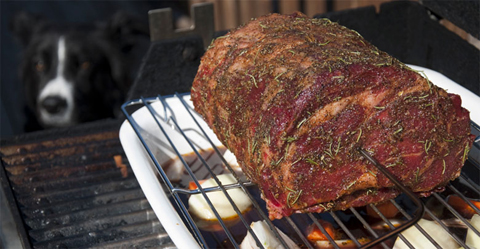
Today’s guest blog is by our friend Craig “Meathead” Goldwyn
and from his great website AmazingRibs.com. I get a lot of positive feedback on his posts so here’s another one. If you put “Craig” in the search box you can find his other posts. Enjoy!
Is there anything more impressive and luxurious than a big juicy standing prime rib roast? Well it’s easy to make outdoors and it definitely tastes better. There are a few tricks to bring it to its peak (and will work well if you are cooking indoors):
1) Go boneless. We will remove the bones so it browns on all sides and save the bones for another great meal. Bones do not add flavor. That’s a myth.
2) A killer crust. We will coat the meat with a paste of oil, herbs, and spices that will create a flavorful crust.
3) Let it sit at room temp. This allows enzymes that are dormant in the cold meat to kick in and tenderize it.
4) A great gravy. We will make great a gravy in a drip pan well below the roast.
5) Just a kiss of smoke. If we are cooking outdoors, we will add wood chips to the fire, just a few, to give it an exotic smokey undertone.
6) Reverse sear. We will cook the interior with indirect convection heat at first and searing it at the end of the cook with direct radiant heat.
Let’s start by getting the name right. Chances are that gorgeous hunk-o-meat in the butcher case is not technically a “prime rib” as most people call it. USDA Prime grade meat, with web like threads of fat running through the muscles for added taste and texture, is an expensive grade that is sold primarily to restaurants. Chances are your grocer’s meat is USDA Choice grade, not USDA Prime grade.
We call it “prime rib” because it comes from a section called the rib primal and that’s what it was called before the current grading system was created and because that’s what they call it in restaurants. But that’s OK. Choice grade is going to make you a pretty darn good dinner because those muscles, located along the back of the steer, are almost always tender and juicy. You can order USDA prime grade meat if you wish, and it’s a real treat, but bring a wheelbarrow full of cash. Otherwise ask your butcher for “top choice” which is the best looking most marbled choice grade roast in the house.
What your grocer has is more properly called a rib roast, but you can call it prime rib if you want. It usually comes in two forms, with the ribs still attached, or boneless. I like to get mine with the bone on, and then I remove the ribs so I can season the meat on all sides.
About going boneless
I know you’ve heard that the bones add flavor. The fact is they don’t. Not in a roast. Submerged under liquid in a stew or braise they produce immense flavor, especially as the marrow dissolves into the liquid. It is essential to leave bones in a stew or braise. But they do not add flavor under the dry heat in a roast.
Think about it. Beef ribs are a honeycomb of marrow inside a casing of calcium wrapped in a sheath of leathery connective tissue. The marrow is not getting through that thick layer of calcium, the calcium is just not getting through the connective tissue, and even if some of it did, the molecules are just not moving more than 1/16″ through the muscle tissue during the cook.
If you leave the bones on, they make a very effective base upon which to stand the roast (hence the name standing rib roast), they act like a heat shield at first until they get fully hot and then they conduct heat and continue to cook the meat after you take it out of the oven.
Most importantly, the bones keep almost half the surface from browning and developing that wonderful rich herbal crust. Brown flavors, created by the maillard effect and caramelization, are among the best part of the meat. I know that gnawing on the bones is fun and tasty, but I submit that if you remove them and make an second meal of them, they will taste better. Beef ribs are a blast.
Another reason to remove the ribs before cooking is because they are a pain to remove at the dinner table when you are carving. Unlike a pork roast, you just cannot cut a slice one bone wide. One bone wide is too much for a normal person. It’s enough for two. To avoid this you can remove the rib slab before cooking an put seasoning on the meat and then tie the bones back on. Fine. But those seasonings and the surface still don’t brown.
So I recommend you get two meals from your roast. Save the bones so they can be smoke roasted Texas or Chicago style or braised.
If you get a roast with ribs on, you should make sure the butcher removes the chine for you. That’s the end of the rib that was connected to the spine. Most of the time is has already been removed, but if it hasn’t it can be a pain to cut through when you try to separate the bones. Having the butcher do this makes carving easier. Even if you are cooking a boneless roast, I recommend you tie it every inch to hold it together and to help make it round which helps it cook more evenly.
